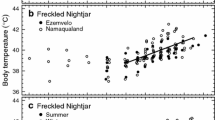Summary
As a means of exploring behavioral and morphological adaptations for thermoregulation in Colias butterflies, convective heat transfer coefficients of real and model butterflies were measured in a wind tunnel as a function of wind speed and body orientation (yaw angle). Results are reported in terms of a dimensionless heat transfer coefficient (Nusselt number, Nu) and a dimensionless wind speed (Reynolds number, Re), for a wind speed range typical of that experienced by basking Colias in the field. The resultant Nusselt-Reynolds (Nu-Re) plots thus indicate the rates of heat transfer by forced convection as a function of wind speed for particular model geometries.
For Reynolds numbers throughout the measured range, Nusselt numbers for C. eurytheme butterflies are consistently lower than those for long cylinders, and are independent of yaw angle. There is significant variation among individual butterflies in heat transfer coefficients throughout the Re range. Model butterflies without artificial fur have Nu-Re relations similar to those for cylinders. Heat transfer in these models depends upon yaw angle, with higher heat transfer at intermediate yaw angles (30–60°); these yaw effects increase with increasing Reynolds number. Models with artificial fur, like real Colias, have Nusselt numbers which are consistently lower than those for models without fur at given Reynolds numbers throughout the Re range. Unlike real Colias, however, the models with fur do show yaw angle effects similar to those for models without fur.
The independence of heat loss from yaw angle for real Colias is consistent with field observations indicating no behavioral orientation to wind direction. The presence of fur on the models reduces heat loss but does not affect yaw dependence. The large individual variation in heat transfer coefficients among butterflies is probably due to differences in fur characteristics rather than to differences in wing morphology.
Finally, a physical model of a butterfly was constructed which accurately simulates the body temperatures of basking Colias in the field for a variety of radiation and wind velocity conditions. The success of the butterfly simulator in mimicking Colias thermal characteristics confirms our preliminary understanding of the physical bases for and heat transfer mechanisms underlying thermoregulatory adaptations in these butterflies.
Similar content being viewed by others
References
Bakken GS (1976) A heat transfer analysis of animals: unifying concepts and the application of metabolic chamber data to field ecology. J Theoret Biol 60:337–84
Douglas MM (1978) (abstract) The behavioral and biophysical strategies of thermoregulation in temperate butterflies. Ann. Arbor Microfilms
Holman JP (1976) Heat transfer. McGraw-Hill, New York
Kays WM (1966) Convective heat and mass transfer. McGraw-Hill, New York
Kingsolver JG (1981) Thermoregulatory strategies in Colias butterflies. PhD thesis, Stanford University
Kline SJ, McClintock FA (1953) Describing uncertainties in singlesample experiments. Mechanical Engineering, January
Kowalski GJ, Mitchell JW (1976) Heat transfer from spheres in the naturally turbulent, outdoor environment. J Heat Transfer 98:649–53
Mitchell JW (1976) Heat transfer from spheres and other animal forms. Biophsical Journal 16:561–69
Porter WP, Mitchell JW, Beckman WA, DeWitt CB (1973) Behavioral implications of mechanistic ecology. Oecologia 13:1–54
Vogel S (1970) Convective cooling at low airspeeds and the shapes of broad leaves. J Exp Bot 21:91–103
Wasserthal LT (1975) The role of butterfly wings in regulation of body temperatures. J Insect Physiol 221:1921–30
Wasserthal, LT (1980) Oscillating haemolymph circulation in the butterfly Papilio machan revealed by contact thermography and photocell measurements. J Comp Physiol (B) 139:145–63
Wathen PJ, Mitchell JW, Porter WP (1974) Heat transfer from animal appendage shapes-cylinders, arcs, and cones, Trans ASME 97:536–54
Watt WB (1968, 1969) Adaptive significance of pigment polymorphisms in Colias butterflies. I. Variation of melanin pigment in relation to thermoregulation. Evolution 22:437–58 II. Thermoregulation and photoperiodically controlled melanin variation of Colias eurutheme. Proc Nat'l Acad Sci 63:767–74 (1969)
Watt WB, Han D, Tabashnik BE (1979) Population structure of pierid butterflies. II. A native population of Colias eriphyle in Colorado. Oecologia (Berl) 44:44–52
Author information
Authors and Affiliations
Rights and permissions
About this article
Cite this article
Kingsolver, J.G., Moffat, R.J. Thermoregulation and the determinants of heat transfer in Colias butterflies. Oecologia 53, 27–33 (1982). https://doi.org/10.1007/BF00377132
Received:
Issue Date:
DOI: https://doi.org/10.1007/BF00377132




